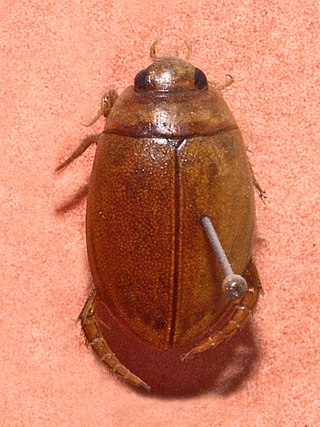
The Anthicidae are a family of beetles that resemble ants. They are sometimes called ant-like flower beetles or ant-like beetles. The family comprises over 3,500 species in about 100 genera.

Amphizoa is a genus of aquatic beetles in the suborder Adephaga, placed in its own monogeneric family, Amphizoidae. There are five known species of Amphizoa, three in western North America and two in the eastern Palearctic. They are sometimes referred to by the common name troutstream beetles.

Derodontidae is a family of beetles, in its own superfamily, Derodontoidea, sometimes known as the tooth-necked fungus beetles. Beetles of this family are small, between 2 and 6 mm in length, typically with spiny margins on their pronotum that give them their name, though the genus Laricobius lacks these spines. Unusual among beetles, they have two ocelli on the top of their heads.

The prothorax is the foremost of the three segments in the thorax of an insect, and bears the first pair of legs. Its principal sclerites are the pronotum (dorsal), the prosternum (ventral), and the propleuron (lateral) on each side. The prothorax never bears wings in extant insects, though some fossil groups possessed wing-like projections. All adult insects possess legs on the prothorax, though in a few groups the forelegs are greatly reduced. In many groups of insects, the pronotum is reduced in size, but in a few it is hypertrophied, such as in all beetles (Coleoptera). In most treehoppers, the pronotum is expanded into often fantastic shapes that enhance their camouflage or mimicry. Similarly, in the Tetrigidae, the pronotum is extended backward to cover the flight wings, supplanting the function of the tegmina.

Cleridae are a family of beetles of the superfamily Cleroidea. They are commonly known as checkered beetles. The family Cleridae has a worldwide distribution, and a variety of habitats and feeding preferences.

The Aderidae, sometimes called ant-like leaf beetles, are a family of beetles that bear some resemblance to ants. The family consists of about 1,000 species in about 40 genera, of which most are tropical, although overall distribution is worldwide.

Larinus is a genus of true weevils, comprising about 180 species, mostly in the Palaearctic region with some species introduced to North America. Turkey appears to have a significant diversity of the group, with more than 50 species recorded in the eastern part of the country.

Georissus, also called minute mud-loving beetles, is the only genus in the beetle family Georissidae. They are tiny insects living in wet soil, often near water. They are found on every continent except Antarctica.

Athous haemorrhoidalis is a species of European and Asian click beetles in the genus Athous. Several variations are recognized.

Graphoderus austriacus is a species of beetle in family Dytiscidae.

Sternocera aequisignata is a species of jewel beetles belonging to the subfamily Julodinae. Its bright metallic green elytra are frequently used in jewellery making.

Cassida denticollis is a species of leaf beetle, situated in the subfamily Cassidinae and the genus Cassida, found in Mongolia, West China, and the Western Palaearctic region.
Neptosternus ceylonicus is a species of beetle. Its holotype was found in Sri Lanka. The specimens were captured in running water or when flying towards light in the evening.
Neptosternus arnecornelii is a species of beetle, named after Arne Cornelius. Its holotype was found in West Kalimantan, Indonesia. The specimens were captured floating on tree roots in a rocky mountain stream near a forest. Neptosternus arnecornelii superficially resembles N. biltoni from the Togian Islands northeast of Sulawesi. It is a small, broadly ovate species; with its body strongly flattened laterally.

Popillia cupricollis is a species of scarab beetles.
Eustra shanghaiensis, is a species of flanged bombardier beetle belonging to the family Carabidae. It is endemic to China.

Polycaon is a genus of horned powder-post beetles in the family Bostrichidae. There are at least four described species in Polycaon.
Tegocassis is a genus of beetles that belongs to the family of leaf beetles (Chrysomelidae), containing a single species, T. corpulenta.

Hister javanicus, is a species of clown beetle found in many Oriental countries including, Taiwan, Java, eastern India, Sri Lanka, and introduced to Africa.
Agathidium jasperanum is a species of round fungus beetle in the family Leiodidae. This species is distinguishable from others in the group by the body somewhat elongate, the punctures on the head distinctly larger than those of pronotum, the elytral punctation coarser and denser than on head and pronotum and with some punctures more or less serially arranged, and the median lobe of the aedeagus elongate and narrow, with the apex slender and apically narrowly rounded. Its type locality is Jasper National Park, Alberta, hence the name.














